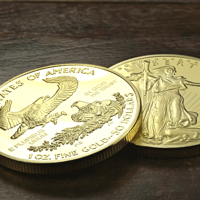Posted on February 02, 2022

Why does the American Eagle objectively stand above other top gold and silver sovereigns? And not just the American Eagle: we can go all the way up to the pricey 20th century Gaudens to prove the point. As we use the word "objectively", coin collectors might already be feeling restless. But whether one wants to admit it or not, our Eagle offers something that other coins can't. It offers Liberty, in more ways than one.
You've just gotten yourself a nice silver Britannia coin. The reverse of the coin is astounding. One of the best designs you'll see on any coin. You flip it around, and it's as if you're woken up to reality. There she stands (or sits?), Queen Elizabeth II, a 140-year old person whose wealth defies being categorized as merely "ultra-rich" and with a unique status as leader of multiple countries around the world.
Sovereign coins from most nations are a reminder that monarchies are alive and well. You want a nice gold and silver coin? Here it is, along with a note of who's really pulling the strings. Our Founding Fathers were not only aware of this, but were seeking to remedy it. It wasn't just a matter of aesthetics: as it happens, the U.S. was trying to establish independence from monarchies.
The 1792 Mint Act was placed specifically to disallow the worship of heroes on coins, especially when those heroes, y'know, haven't really done anything for us. By 1909 Lincoln snuck onto his first penny, and remains on select U.S. coinage today. Still, it's more of an homage than anything foreign sovereigns pull. Regardless of your stances on various issues, how would you feel if you flipped a nickel and President Biden's dome was there to greet you? Especially on a gold or silver coin you paid quite the pretty penny for...
And that's why the American Eagle stands head and shoulders above the rest. You check the reverse, it's the eagle: our national symbol. You flip it, there's Liberty: another of our national symbols. She is neither wealthier than you nor a super-centenarian wearing a crown. It's refreshing to say the least. Of course, there's no denying there's a market for "monarchic" coins.
Long story short, in 1936, marital affairs made Edward VIII abdicate the throne to his brother, George VI. Married life was more interesting to Edward than the whole ruling thing, specifically married life with an American divorcée (double taboo). However, mints were already ready, and some "pre-coins" were issued that are on museum display today. These remain one of the most unique gold sovereigns, and not just because of Edward's abdication.
As if he had to drive the point of not being into traditional customs across further, Edward had his portrait face the opposite side of what it was supposed to. The reason? His hairstyle. By tradition, he should have been facing right, but he insisted on facing left because the part in his hair made that side look better, he thought.
The 20-francs gold coin is another example of why putting people on coins can be messy business. Napoleon's introduction into the design was essentially a weaker version of what our Founding Fathers mapped out. Bye bye, strange-looking monarchs: hello, revered military figure.
Just as Napoleon's era had plenty of those opposing the iconic historical figure, on coinage or otherwise, so too do plenty of investors today not necessarily agree with the views of our Founding Fathers. They'll buy up every King Charles coin they can find and pay quite a premium for the now out of circulation Queen Elizabeth ones.
It's a showcase of the diversity of tastes on one hand and a critique of numismatics on the other. A little diversity might not hurt when it comes to top coins. If China has resisted placing Xi on the obverse of its Panda series, do buyers of Britannias really have to endure... ah, admire King Charles' persona without exception?
Photo by Björn Wylezich